The Giornate del Cinema Muto honours the 50 years of existence of The Parade’s Gone By. British film historian Kevin Brownlow’s classic oral history survey was first published in 1968. Not a history book in the usual sense, it describes early Hollywood primarily through the recollections of people who were there. As Lincoln Specter concludes in a post on his blog Bayflicks: "The current access to silent films that we all enjoy is, to a large extent, the result of Brownlow’s life work. And The Parade’s Gone By was the beginning." Six American silent films which were discussed in Brownlow's study will be presented in a special programme in Pordenone. To honour Giornate, Brownlow’s work and silent Hollywood, we selected a series of postcards on the stars and on one of the directors of these six films, plus some additional cards on early studios.

James Cruze. American postcard by Krauss Mfg. Co., New York. Photo: Thanhouser. Publicity still for the 23-episode serial The Million Dollar Mystery (Howard Hansel, 1914), produced by Thanhouser. See for the flipside the picture below.

American postcard. Krauss Mfg. Co., New York. Thanhouser. Retro of a postcard for James Cruze in the 23 episodes counting Thanhouser serial The Million Dollar Mystery (Howard Hansel, 1914), starring Cruze and Florence La Badie. The card says the actor will personally appear at the Crescent Theater on Saturday, May 22nd., "to tell about his experiences in the motion picture world and shake hands with all his admirers". The serial is presumably lost. This card refers to a screening on Saturday 22 May 1915, while the serial had started in June 1914. The Crescent may refer to the Ithaca cinema The Crescent, that opened in 1914. Its rival, the Star Cinema, had shown the serial in the Summer of 1914.
The oldest film shown in the programme is The Covered Wagon (James Cruze, 1923), starring J. Warren Kerrigan and Lois Wilson. James Cruze (1884-1942) was an American actor and director of the silent screen. At the age of 16, he played his first roles on the stage and in 1906 he became a member of the then-well-known Belasco troupe, with whom he performed regularly on Broadway. Already in 1908 he changed profession and participated in countless films of first Lubin, from 1910, and from 1912 onwards at the Thanhouser film company, both East Coast companies. In 1915 Thanhouser dismissed Cruze's despite the success of his serials The Million Dollar Mystery and Zudora (both 1914).
Cruze moved to Hollywood in the mid-1910s and began his career as a director in 1919, primarily for Paramount. He first became known through several comedies with Wallace Reid and Fatty Arbuckle in the lead roles. Most of his Arbuckle comedies were withdrawn and destroyed after 1921, at the height of the scandal around the silent film actor.
Cruze's best-known film is the Western The Covered Wagon (1923), depicting the migration of German emigrants to the West of North America and their conflicts with each other and with Indians. The film was carefully researched with great eye for detail. It was one of the most commercially successful representatives of his genre from the early days of film and received several awards.
James Cruze's film Hollywood, also released in 1923, was the first film to cast a critical eye over the facade of the dream factory, relentlessly revealing the manipulation of the audience through partially fictitious stories about the stars of the screen. At the same time, the film was a tribute to Fatty Arbuckle and did not spare criticism of the behaviour of the producers towards the actor.
In 1925 Cruze used techniques from German Expressionism for work on Beggar on a Horseback and was able to convince the critics with a dense dramaturgy and for the time exciting new camera settings. His demise began the following year, as the Western Old Ironside, produced with high financial cost, flopped at the box office. It would take years before another lavishly produced Western came into the national cinemas. In the 1930s, James Cruze's career faltered. In 1938 he retired after some B-movies and in 1942 he died completely impoverished and largely forgotten.

J. Warren Kerrigan. British postcard.
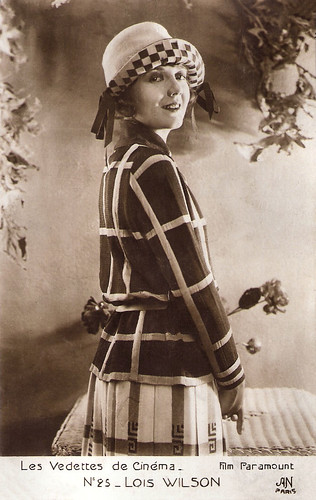
Lois Wilson. French postcard in the Les Vedettes de Cinéma series by A.N., Paris, no. 25. Photo: Paramount.
The second film in the Parade’s Gone By homage is the Vitagraph production Captain Blood (David Smith, 1924), starring Jean Paige and J. Warren Kerrigan. Jean Paige (1895-1990) was a silent film actress whose whole career happened at the Vitagraph company. Eventually, she married its president.
Jean Paige was born Lucile Beatrice O'Hair in 1895 in Paris, Illinois and was raised on her father's farm there, developing a love for horses while living there. Paige made twenty-one films in a career which began in 1917 at the Vitagraph company and concluded there in 1924. Her first screen appearance came in two-reeler features based on O'Henry stories, starting with Blind Man's Holiday (Martin Justice, 1917).
She came to prominence in the Vitagraph film Too Many Crooks (Ralph Ince, 1919). As Charlotte Brown, she made a star part out of a bit part. Jean had never appeared on stage and had no experience in movies before becoming a Vitagraph leading woman.
Her role in Too Many Crooks led Vitagraph president Albert E. Smith to elevate her position at the film studio. Remarkable feature-length films at Vitagraph with Paige starring were a.o. The Darkest Hour (Paul Scardon, 1919), Daring Hearts (Henry Houry, 1919), The Birth of a Soul (Edwin L. Hollywood, 1920), Black Beauty (David Smith, 1921), The Prodigal Judge (Edward José, 1922), and her final film, Captain Blood (uncredited: David Smith, Albert E. Smith, 1924).
Eventually, Paige married Smith himself in 1920 - she was his third wife. She stopped acting and they stayed together until he died in 1958. In 1925 Vitagraph was sold to Warner Bros. In 1931, Smith bought the residential apartment building of Chateau Marmont and turned it into a hotel.
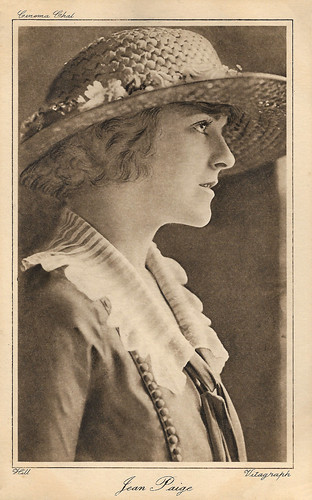
British postcard by Cinema Chat. Photo: Hill / Vitagraph. Jean Paige.
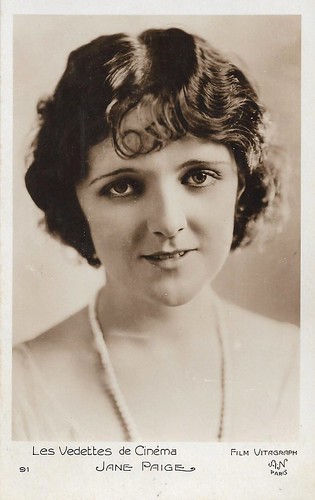
Jane Paige aka Jean Paige. French postcard by A.N., Paris in the Les Vedettes de Cinéma series, no. 91. Photo: Film Vitagraph.
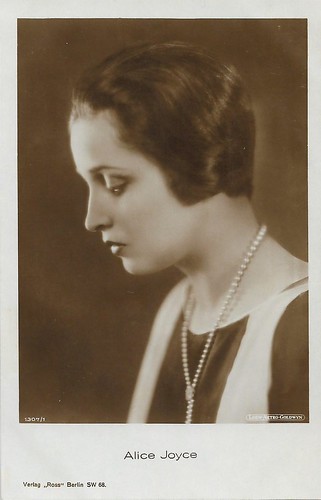
Alice Joyce. German postcard by Ross Verlag, no. 1307/1. Photo: Loew-Metro-Goldwyn.
The stars of The Home Maker (King Baggot, 1925) were Alice Joyce and Clive Brook. The film was produced by King Baggot Productions and Universal. Alice Joyce (1890-1955) was an American screen actress, who, at the peak of her career, was nicknamed the Madonna of the Screen. Born in Kansas City, Joyce began her career as a telephone operator. Through various model activities, she got her first role in the film.
From 1910 on, she quickly rose to become one of the biggest stars of Kalem Studios and played mostly well-behaved ladies of the better society in melodramas, comedies and occasionally crime stories. After the merger of Kalem and Vitagraph in 1916, the popularity of Joyce increased. Until the 1920s she specialised in naive women, but slowly, she also took on some mature roles. In 1924 she acted opposite Clive Brook in the British production The Passionate Adventure by Graham Cutts.
1925 was one of her most productive years. She played opposite Percy Marmont in Frank Borzage's Daddy's Gone A-Hunting. She was Stella's rival Helen Morrison in Henry King's Stella Dallas. And she was Clara Bow's mother in Herbert Brenon's Dancing Mothers, one of Joyce's greatest successes. In the latter, she is a woman who is denied any pleasure in life by her heartless husband and thoughtless daughter.
In 1925 Joyce also played opposite Clive Brook in King Baggot’s The Home Maker, about a man crippled after a failed suicide attempt. He switches roles with his wife, who climbs the corporate ladder at his old company. Both are happy with the new situation until the man discovers that his legs are getting better. In 1926 she played a princess opposite W.C. Fields in the comedy So's Your Old Man by Gregory La Cava. In 1927 Joyce signed a well-endowed contract with First National, where she received a few substantial film roles, as in The Squall (Alexander Korda, 1929), starring Myrna Loy.
Joyce made a smooth transition from silent film to sound film and in 1930 co-acted with George Arliss in The Green Goddess, the remake of a film in which both stars had had a success in 1923. However, a lengthy heart disease (Louise Brooks claims that it was an alcohol problem) forced her into private life after 1930.
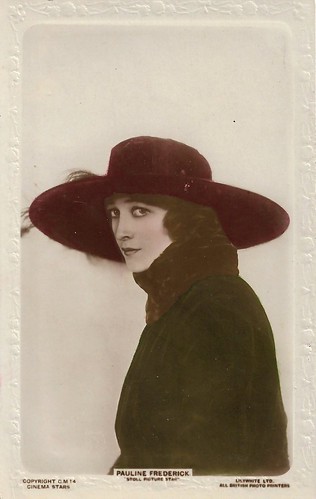
Pauline Frederick. British postcard by Lilywhite Ltd. Photo: Stoll Pictures.
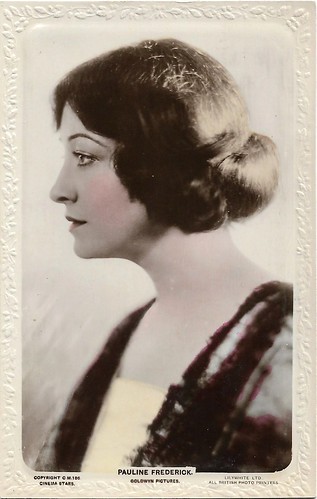
Pauline Frederick. British postcard by Lilywhite Ltd. Photo: Goldwyn Pictures.
Another film in the Parade’s Gone By homage is the Universal production Smouldering Fires (Clarence Brown, 1925), starring Pauline Frederick. Pauline Frederick (1883-1938) was an American theatre and film actress. Frederick made a name for herself in the theatre and had already passed thirty when she became successful in Hollywood. In the period of silent film, she was one of the most powerful actresses in the film industry.
In 1914 Pauline Frederick was hired by Famous Players. She saw the film industry as a temporary get-away, but encouraged by the success of her first role in The Eternal City (Hugh Ford, Edwin S. Porter, 1915) she signed a contract. Although she had already passed 30, she became one of the biggest stars in the silent film period. She played mainly sophisticated or demanding, classy women and femme fatales. In 1919 Frederick signed a contract with Goldwyn Pictures. Critics agreed that she was assigned roles there that were more suitable for her. The budget of the films she worked on was larger and the films were better received in terms of quality.
Although her career ran smoothly, her private life was a disaster. Her first husband was a violent alcoholic and drug addict who regularly mistreated his wife, so in 1919 she applied for a divorce. As a result of the relocation of Goldwyn, Frederick moved to California in 1920. That same year she played in Madame X (Frank Lloyd, 1920), the movie she became most familiar with. Despite the success she enjoyed at Goldwyn, she left the studio for a contract with Robertson-Cole, where she received a fixed salary of $ 7,000 per week. It was a misstep in her career. Most films flopped and reviewers spoke negatively about it. In 1922 her contract was terminated and she returned to the stage.
In 1924 she was hired by the Vitagraph Company and achieved success in films such as Three Women (Ernst Lubitsch, 1924), with May McAvoy and Marie Prevost as the other women and Lew Cody as the man in the middle, and Smouldering Fires (Clarence Brown, 1925), in which she is a successful businesswoman who marries her younger employee (Malcolm McGregor), though he is in love with her younger sister (Laura LaPlante). Frederick became a role model and style icon for elder women.
Her career dwindled in the 1930s. The reason was not so much the new sound film (as Frederick had good diction) but rather the loss of prestige. Her private life was increasingly getting difficult, with unfortunate marriages and the death of her mother, but it was her asthma that killed her in 1938 at the age of 55.
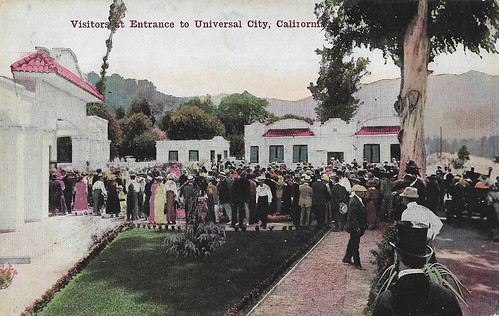
Visitors at Entrance to Universal City. American postcard by Van Ornum Colorprint Co, Los Angeles, no. 778. This postcard may refer to the opening of the Second Universal City on Lankershim Bd. on 15 March 1915.
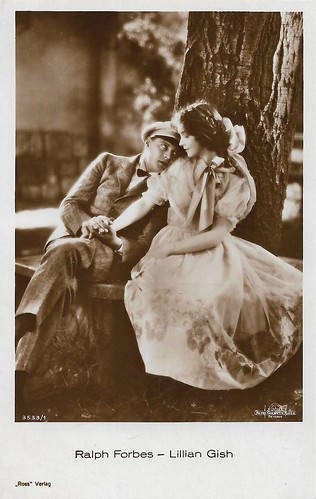
German postcard by Ross Verlag, no. 3533/1. Photo: MGM. Lillian Gish and Ralph Forbes in The Enemy (Fred Niblo, 1927).
Lillian Gish and Ralph Forbes were the stars in the MGM production The Enemy (Fred Niblo, 1927). The plot takes place in Austria during the First World War. Carl Behrend (Ralph Forbes) and Pauli Arndt (Lillian Gish) have just married. He is the son of a businessman (George Fawcett), and she is the daughter of a professor (Frank Currier).
When the First World War breaks out, Carl is drafted and called to the front. There he has to endure major suffering. Life is hard for those left behind too. Pauli is starving and despairs, even more so when her father is revoked for his pacifist opinions. She becomes a prostitute and loses her baby...
Handsome English actor Ralph Forbes (1904–1951) started his film career in the British cinema before he became a Hollywood star of the 1920s and 1930s. Later he turned into a noted Broadway actor.
American actress Lillian Gish (1893-1993) was 'The First Lady of the Silent Screen'. During the 1910s, she was one of director D.W. Griffith's greatest stars. She appeared in such classic features as The Birth of a Nation (D.W. Griffith, 1915), Broken Blossoms (D.W. Griffith, 1919), and Orphans of the Storm (D.W. Griffith, 1921).

James Cruze. American postcard by Krauss Mfg. Co., New York. Photo: Thanhouser. Publicity still for the 23-episode serial The Million Dollar Mystery (Howard Hansel, 1914), produced by Thanhouser. See for the flipside the picture below.

American postcard. Krauss Mfg. Co., New York. Thanhouser. Retro of a postcard for James Cruze in the 23 episodes counting Thanhouser serial The Million Dollar Mystery (Howard Hansel, 1914), starring Cruze and Florence La Badie. The card says the actor will personally appear at the Crescent Theater on Saturday, May 22nd., "to tell about his experiences in the motion picture world and shake hands with all his admirers". The serial is presumably lost. This card refers to a screening on Saturday 22 May 1915, while the serial had started in June 1914. The Crescent may refer to the Ithaca cinema The Crescent, that opened in 1914. Its rival, the Star Cinema, had shown the serial in the Summer of 1914.
James Cruze
The oldest film shown in the programme is The Covered Wagon (James Cruze, 1923), starring J. Warren Kerrigan and Lois Wilson. James Cruze (1884-1942) was an American actor and director of the silent screen. At the age of 16, he played his first roles on the stage and in 1906 he became a member of the then-well-known Belasco troupe, with whom he performed regularly on Broadway. Already in 1908 he changed profession and participated in countless films of first Lubin, from 1910, and from 1912 onwards at the Thanhouser film company, both East Coast companies. In 1915 Thanhouser dismissed Cruze's despite the success of his serials The Million Dollar Mystery and Zudora (both 1914).
Cruze moved to Hollywood in the mid-1910s and began his career as a director in 1919, primarily for Paramount. He first became known through several comedies with Wallace Reid and Fatty Arbuckle in the lead roles. Most of his Arbuckle comedies were withdrawn and destroyed after 1921, at the height of the scandal around the silent film actor.
Cruze's best-known film is the Western The Covered Wagon (1923), depicting the migration of German emigrants to the West of North America and their conflicts with each other and with Indians. The film was carefully researched with great eye for detail. It was one of the most commercially successful representatives of his genre from the early days of film and received several awards.
James Cruze's film Hollywood, also released in 1923, was the first film to cast a critical eye over the facade of the dream factory, relentlessly revealing the manipulation of the audience through partially fictitious stories about the stars of the screen. At the same time, the film was a tribute to Fatty Arbuckle and did not spare criticism of the behaviour of the producers towards the actor.
In 1925 Cruze used techniques from German Expressionism for work on Beggar on a Horseback and was able to convince the critics with a dense dramaturgy and for the time exciting new camera settings. His demise began the following year, as the Western Old Ironside, produced with high financial cost, flopped at the box office. It would take years before another lavishly produced Western came into the national cinemas. In the 1930s, James Cruze's career faltered. In 1938 he retired after some B-movies and in 1942 he died completely impoverished and largely forgotten.

J. Warren Kerrigan. British postcard.

Lois Wilson. French postcard in the Les Vedettes de Cinéma series by A.N., Paris, no. 25. Photo: Paramount.
Jean Paige
The second film in the Parade’s Gone By homage is the Vitagraph production Captain Blood (David Smith, 1924), starring Jean Paige and J. Warren Kerrigan. Jean Paige (1895-1990) was a silent film actress whose whole career happened at the Vitagraph company. Eventually, she married its president.
Jean Paige was born Lucile Beatrice O'Hair in 1895 in Paris, Illinois and was raised on her father's farm there, developing a love for horses while living there. Paige made twenty-one films in a career which began in 1917 at the Vitagraph company and concluded there in 1924. Her first screen appearance came in two-reeler features based on O'Henry stories, starting with Blind Man's Holiday (Martin Justice, 1917).
She came to prominence in the Vitagraph film Too Many Crooks (Ralph Ince, 1919). As Charlotte Brown, she made a star part out of a bit part. Jean had never appeared on stage and had no experience in movies before becoming a Vitagraph leading woman.
Her role in Too Many Crooks led Vitagraph president Albert E. Smith to elevate her position at the film studio. Remarkable feature-length films at Vitagraph with Paige starring were a.o. The Darkest Hour (Paul Scardon, 1919), Daring Hearts (Henry Houry, 1919), The Birth of a Soul (Edwin L. Hollywood, 1920), Black Beauty (David Smith, 1921), The Prodigal Judge (Edward José, 1922), and her final film, Captain Blood (uncredited: David Smith, Albert E. Smith, 1924).
Eventually, Paige married Smith himself in 1920 - she was his third wife. She stopped acting and they stayed together until he died in 1958. In 1925 Vitagraph was sold to Warner Bros. In 1931, Smith bought the residential apartment building of Chateau Marmont and turned it into a hotel.

British postcard by Cinema Chat. Photo: Hill / Vitagraph. Jean Paige.

Jane Paige aka Jean Paige. French postcard by A.N., Paris in the Les Vedettes de Cinéma series, no. 91. Photo: Film Vitagraph.

Alice Joyce. German postcard by Ross Verlag, no. 1307/1. Photo: Loew-Metro-Goldwyn.
Alice Joyce
The stars of The Home Maker (King Baggot, 1925) were Alice Joyce and Clive Brook. The film was produced by King Baggot Productions and Universal. Alice Joyce (1890-1955) was an American screen actress, who, at the peak of her career, was nicknamed the Madonna of the Screen. Born in Kansas City, Joyce began her career as a telephone operator. Through various model activities, she got her first role in the film.
From 1910 on, she quickly rose to become one of the biggest stars of Kalem Studios and played mostly well-behaved ladies of the better society in melodramas, comedies and occasionally crime stories. After the merger of Kalem and Vitagraph in 1916, the popularity of Joyce increased. Until the 1920s she specialised in naive women, but slowly, she also took on some mature roles. In 1924 she acted opposite Clive Brook in the British production The Passionate Adventure by Graham Cutts.
1925 was one of her most productive years. She played opposite Percy Marmont in Frank Borzage's Daddy's Gone A-Hunting. She was Stella's rival Helen Morrison in Henry King's Stella Dallas. And she was Clara Bow's mother in Herbert Brenon's Dancing Mothers, one of Joyce's greatest successes. In the latter, she is a woman who is denied any pleasure in life by her heartless husband and thoughtless daughter.
In 1925 Joyce also played opposite Clive Brook in King Baggot’s The Home Maker, about a man crippled after a failed suicide attempt. He switches roles with his wife, who climbs the corporate ladder at his old company. Both are happy with the new situation until the man discovers that his legs are getting better. In 1926 she played a princess opposite W.C. Fields in the comedy So's Your Old Man by Gregory La Cava. In 1927 Joyce signed a well-endowed contract with First National, where she received a few substantial film roles, as in The Squall (Alexander Korda, 1929), starring Myrna Loy.
Joyce made a smooth transition from silent film to sound film and in 1930 co-acted with George Arliss in The Green Goddess, the remake of a film in which both stars had had a success in 1923. However, a lengthy heart disease (Louise Brooks claims that it was an alcohol problem) forced her into private life after 1930.

Pauline Frederick. British postcard by Lilywhite Ltd. Photo: Stoll Pictures.

Pauline Frederick. British postcard by Lilywhite Ltd. Photo: Goldwyn Pictures.
Pauline Frederick
Another film in the Parade’s Gone By homage is the Universal production Smouldering Fires (Clarence Brown, 1925), starring Pauline Frederick. Pauline Frederick (1883-1938) was an American theatre and film actress. Frederick made a name for herself in the theatre and had already passed thirty when she became successful in Hollywood. In the period of silent film, she was one of the most powerful actresses in the film industry.
In 1914 Pauline Frederick was hired by Famous Players. She saw the film industry as a temporary get-away, but encouraged by the success of her first role in The Eternal City (Hugh Ford, Edwin S. Porter, 1915) she signed a contract. Although she had already passed 30, she became one of the biggest stars in the silent film period. She played mainly sophisticated or demanding, classy women and femme fatales. In 1919 Frederick signed a contract with Goldwyn Pictures. Critics agreed that she was assigned roles there that were more suitable for her. The budget of the films she worked on was larger and the films were better received in terms of quality.
Although her career ran smoothly, her private life was a disaster. Her first husband was a violent alcoholic and drug addict who regularly mistreated his wife, so in 1919 she applied for a divorce. As a result of the relocation of Goldwyn, Frederick moved to California in 1920. That same year she played in Madame X (Frank Lloyd, 1920), the movie she became most familiar with. Despite the success she enjoyed at Goldwyn, she left the studio for a contract with Robertson-Cole, where she received a fixed salary of $ 7,000 per week. It was a misstep in her career. Most films flopped and reviewers spoke negatively about it. In 1922 her contract was terminated and she returned to the stage.
In 1924 she was hired by the Vitagraph Company and achieved success in films such as Three Women (Ernst Lubitsch, 1924), with May McAvoy and Marie Prevost as the other women and Lew Cody as the man in the middle, and Smouldering Fires (Clarence Brown, 1925), in which she is a successful businesswoman who marries her younger employee (Malcolm McGregor), though he is in love with her younger sister (Laura LaPlante). Frederick became a role model and style icon for elder women.
Her career dwindled in the 1930s. The reason was not so much the new sound film (as Frederick had good diction) but rather the loss of prestige. Her private life was increasingly getting difficult, with unfortunate marriages and the death of her mother, but it was her asthma that killed her in 1938 at the age of 55.

Visitors at Entrance to Universal City. American postcard by Van Ornum Colorprint Co, Los Angeles, no. 778. This postcard may refer to the opening of the Second Universal City on Lankershim Bd. on 15 March 1915.

German postcard by Ross Verlag, no. 3533/1. Photo: MGM. Lillian Gish and Ralph Forbes in The Enemy (Fred Niblo, 1927).
Lillian Gish
Lillian Gish and Ralph Forbes were the stars in the MGM production The Enemy (Fred Niblo, 1927). The plot takes place in Austria during the First World War. Carl Behrend (Ralph Forbes) and Pauli Arndt (Lillian Gish) have just married. He is the son of a businessman (George Fawcett), and she is the daughter of a professor (Frank Currier).
When the First World War breaks out, Carl is drafted and called to the front. There he has to endure major suffering. Life is hard for those left behind too. Pauli is starving and despairs, even more so when her father is revoked for his pacifist opinions. She becomes a prostitute and loses her baby...
Handsome English actor Ralph Forbes (1904–1951) started his film career in the British cinema before he became a Hollywood star of the 1920s and 1930s. Later he turned into a noted Broadway actor.
American actress Lillian Gish (1893-1993) was 'The First Lady of the Silent Screen'. During the 1910s, she was one of director D.W. Griffith's greatest stars. She appeared in such classic features as The Birth of a Nation (D.W. Griffith, 1915), Broken Blossoms (D.W. Griffith, 1919), and Orphans of the Storm (D.W. Griffith, 1921).
After 13 years with Griffith, she moved to MGM where her first picture was La bohème (1926). In the 1940s, she again appeared in a handful of films and received a Best Supporting Actress Oscar nomination for her role as Laura Belle McCanles in Duel in the Sun (King Vidor, 1946). Her last film was The Whales of August (Lindsay Anderson, 1987) in which she shared the lead with Bette Davis.

The Metro studios. American postcard by California Postcard Co., Los Angeles. Photo: Glen G. Stone, Los Angeles. The caption at the flipside: "Showing the space-saving device of building a 'set' within a 'set', and further of setting up an 'exterior' within an 'interior'. A mining town street scene is in the course of construction within a palatial drawing-room; an interesting side-light on picture-making ingenuity."

Evelyn Brent. German postcard by Ross Verlag, no. 4004/1, 1929-1930. Photo: Paramount.
Thomas Meighan
A final film in the Parade’s Gone By homage is another film by James Cruze, The Mating Call (James Cruze, 1928), a production by The Caddo Company and Paramount, 1928). The star was American stage and screen actor Thomas Meighan (1879-1936). Thomas Meighan began his acting career as a stage performer on Broadway, between 1900 and 1912. Though he became a well-known film star from the late 1910s on, he remained devoted to the stage. This is also where he met his wife, Frances Ring.
From 1914 to 1928, Meighan contributed to nearly eighty silent films, mostly produced by the Famous Players-Lasky Corporation. In 1915 Famous Players gave Meighan a contract. In 1919 he had his breakthrough with The Miracle Man (George Loane Tucker, 1919), about con men who want to use a faith healer to collect money. The film co-starred Betty Compson and Lon Chaney.
Notably, Meighan appeared in seven films by William C. de Mille and five others by his brother Cecil B. DeMille. Three of these are among his best-known films, Male and Female (Cecil B. DeMille, 1919), Why Change Your Wife? (Cecil B. DeMille, 1920) and Manslaughter (Cecil B. DeMille, 1922).
His female partners included Renée Adorée (two films), Louise Brooks (one film The City Gone Wild (James Cruze, 1927)), Billie Burke (five films), Gloria Swanson and Bebe Daniels (two films, Male and Female and Why Change Your Wife?), Pauline Frederick (five films), Leatrice Joy (three films in 1922, including Manslaughter), Lila Lee (eleven films, including Male and Female, their first ensemble), Mary Pickford (one film: M'liss (Marshall Neilan, 1918)), Blanche Sweet (five films), Norma Talmadge (three films), Virginia Valli (two films), and Lois Wilson (five films, including Manslaughter).
His final silent films were The Mating Call and Racket, both produced by Howard Hughes in 1928. The Mating Call deals with a soldier who returns home from World War I to find his – secret - marriage has been annulled and his wife (Evelyn Brent) has remarried. At Ellis Island he finds a French woman to pose as his wife (Renée Adorée) but they gradually fall in love. Thomas Meighan's first sound feature film was Howard Bretherton's The Argyle Case, with HB Warner, Lila Lee, and Zasu Pitts, and released in 1929. Meighan only made five other talking movies, the last one being Peck's Bad Boy (Edward F. Cline, 1934) with Jackie Cooper. Two years later, in 1936, Meighan died prematurely of lung cancer. Meighan was involved in two Hollywood scandals: he was the only witness at the secret marriage of Jack Pickford and Olive Thomas, and he paid a large share of the bail to get Rudolph Valentino out of prison after the latter was accused of bigamy.
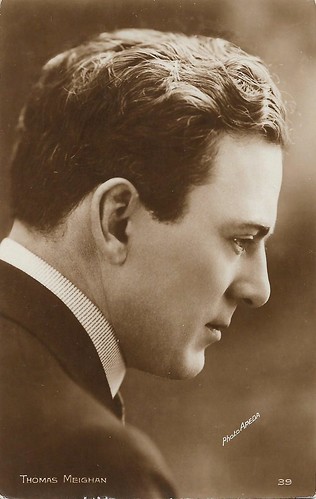
Thomas Meighan. French postcard by Editions Cinémagazine, no. 39. Photo: Apeda.

Thomas Meighan and his not-so-happy-looking children. French postcard by A.N. Paris, in the Les Vedettes de Cinéma series, no. 21. Photo: Paramount.
Sources: Lincoln Specter (Bay Flicks), Wikipedia and IMDb.
This post was last updated on 11 November 2023.
1 comment:
Cracking
Post a Comment